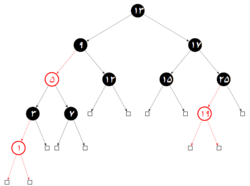Left-leaning red–black tree
From HandWiki
| Left-leaning red–black tree | |||||||||||||||||||||
|---|---|---|---|---|---|---|---|---|---|---|---|---|---|---|---|---|---|---|---|---|---|
 | |||||||||||||||||||||
| Type | tree | ||||||||||||||||||||
| Invented | 2008 | ||||||||||||||||||||
| Invented by | Robert Sedgewick | ||||||||||||||||||||
| Time complexity in big O notation | |||||||||||||||||||||
| |||||||||||||||||||||
A left-leaning red–black (LLRB) tree is a type of self-balancing binary search tree. It is a variant of the red–black tree and guarantees the same asymptotic complexity for operations, but is designed to be easier to implement.
Properties of a left-leaning red–black tree
All of the red-black tree algorithms that have been proposed are characterized by a worst-case search time bounded by a small constant multiple of log N in a tree of N keys, and the behavior observed in practice is typically that same multiple faster than the worst-case bound, close to the optimal log N nodes examined that would be observed in a perfectly balanced tree.
Specifically, in a left-leaning red-black 2–3 tree built from N random keys:
- A random successful search examines log2 N − 0.5 nodes.
- The average tree height is about 2 log2 N
- The average size of left subtree exhibits log-oscillating behavior.
Bibliography
- Robert Sedgewick's Java implementation of LLRB from his 2008's paper
- Robert Sedgewick. 20 Apr 2008. Animations of LLRB operations
- Open Data Structures - Section 9.2.2 - Left-Leaning Red–Black Trees, Pat Morin
External links
- Robert Sedgewick. Left-leaning Red–Black Trees. Direct link to PDF.
- Robert Sedgewick. Left-Leaning Red–Black Trees slides from April 2008.
- Linus Ek, Ola Holmström and Stevan Andjelkovic. May 19, 2009. Formalizing Arne Andersson trees and Left-leaning Red–Black trees in Agda
- Julien Oster. March 22, 2011. An Agda implementation of deletion in Left-leaning Red–Black trees
- Kazu Yamamoto. 2011.10.19. Purely Functional Left-Leaning Red–Black Trees
- Left-Leaning Red-Black Trees Considered Harmful
 |

